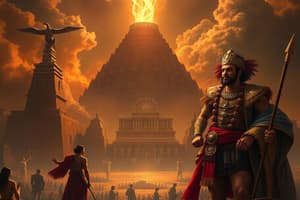Podcast
Questions and Answers
What does the term 'Independence' refer to in the context of Latin America's history?
What does the term 'Independence' refer to in the context of Latin America's history?
The period from 1810-1825 when Latin America sought independence from Spain.
Who were the Creoles?
Who were the Creoles?
Spanish white people born in Latin America.
Who were the Peninsulares?
Who were the Peninsulares?
Spanish born white people sent by the monarch to rule in Latin America.
Who was Miguel Hidalgo?
Who was Miguel Hidalgo?
What was the significance of Hidalgo's actions?
What was the significance of Hidalgo's actions?
Who was Jose Maria Morelos?
Who was Jose Maria Morelos?
What does 'Americanos' mean?
What does 'Americanos' mean?
Creoles wanted equality before the independence movement succeeded.
Creoles wanted equality before the independence movement succeeded.
Who was Agustin de Iturbide?
Who was Agustin de Iturbide?
Flashcards are hidden until you start studying
Study Notes
Independence (1810-1825)
- Spain established the Caste System in Latin America, a social hierarchy based on race, with Peninsulares (Spanish-born) at the top.
- Creoles, born in Latin America of Spanish descent, resented the Peninsulares due to lack of political power despite being socially prominent.
- Lower castes (indigenous and African slaves) remained passive under the Peninsulares but resented Creoles who also ruled them.
- Creole discontent sparked the revolution for independence from Spanish rule.
Creoles
- Creoles were Spanish white individuals born in Latin America, located just below Peninsulares in the social hierarchy.
Peninsulares
- Peninsulares were the highest social class, consisting of Spanish-born white people sent by the monarch to govern Latin American colonies.
Miguel Hidalgo
- Hidalgo was a non-conformist Creole priest and a revolutionary figure known for initiating the Mexican independence movement.
- He leveraged his knowledge of indigenous languages and religious sentiments to rally mestizos and indigenous people against Peninsulares.
- Famous for his rallying cry that included references to the Virgin of Guadalupe, which became a symbol of the revolution.
- Captured and executed in 1811; his death served as a warning against further revolts.
Jose Maria Morelos
- Morelos was a Mestizo priest and pivotal leader in the independence movement who advanced a vision of equality.
- In 1813, he declared all individuals born in Mexico as "Americanos" and called for the abolition of slavery and the Caste System.
- Morelos was captured and executed in 1815 but sustained momentum for the movement until his death.
Americanos
- The term "Americanos," coined by Morelos, referred to all individuals born in Latin America, promoting a sense of shared identity among diverse groups.
- Nativism emerged as a unifying force, positioning all Americanos against foreign rule and emphasizing governance by the people of Latin America.
- Despite initial ideals of equality, post-independence, the social hierarchy largely remained with Creoles replacing Peninsulares at the top.
Agustin de Iturbide
- Iturbide was a Creole army commander who played a key role in the independence movement and later assumed leadership after the revolution.
Studying That Suits You
Use AI to generate personalized quizzes and flashcards to suit your learning preferences.




